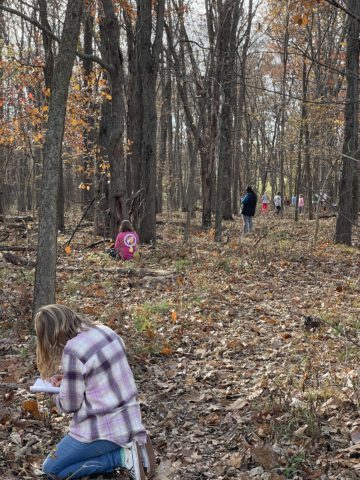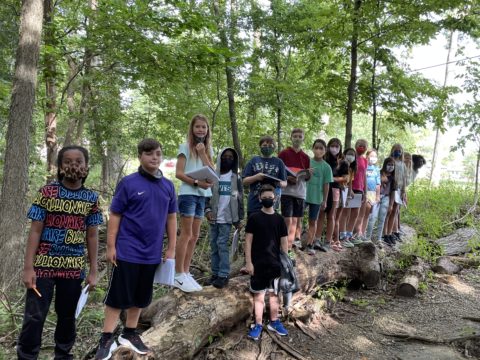What was your driving question?
What types of trees are here in our local park and how has this environment changed the life of the tree? How might we understand and inform others about the varying trees of the Fairview woods and preserve the value of nature?
Grades Involved
How did this project connect to your local or regional community?
Students researched tree species in a local city park and created educational signs to be posted to inform patrons of the park. Fairview woods is a public access area with trails; it is not solely for the students of Fairview Elementary School. In their classes, 5th-grade students focused on the identified trees within the woods and compared them to the trees in their own neighborhoods and backyards. Additionally, when community members heard about the adoption of Place-Based Education, they reached out to help in whatever way possible.
What PBE principles were highlighted in this project?
Learner-Centered, Community as Classroom, Interdisciplinary Approach, Inquiry Based
Content Area(s)
- English/Language Arts
- Mathematics
- Social Studies
- Arts & Music
- Science
Project Description
5th-grade students from the Fairview Elementary School took part in an inquiry and learner-based exploration of the Fairview Woods. Place-Based education in the Fairview woods was implemented at least once a week and included interdisciplinary discoveries. The first time out the students spent time individually journaling and sketching their observations of different tree types, the trunk size, and bark texture. Math and Science were applied through tree measurements and identification of the different species; English included written responses to a book about a girl saving a tree; Social Studies looked into which trees may have been planted, and what the woods may have looked like prior to now.
Each group of students chose a specific type of tree to identify and research. They became experts on the species and learned to identify their species in all seasons. They taught other groups about their tree species and how to identify it. They then chose a plot to count how many trees of their species were located in that smaller area to estimate the number of trees of their species that could be in the forest. Students then designed educational signs to be made by students in our STEAM middle school that will be posted in the park to educate those who use the park. Students will then have the opportunity to work with students in the forestry program at the University of Missouri to core some trees of their particular species to get an idea of how old the forest is. They are then going to write historical fiction pieces about the history these trees have witnessed.
How did this positively impact the community? How was it shared?
Students collaborated and shared with other students and the signs will be installed in the park along the trails so that all that visit and use the park will have access to the information. Surrounding communities positively support the school’s adoption of Place-Based Education. Community members and parents have partnered to build a permanent shed to store donated raincoats and boots and activity boxes for student and community use. The fifth graders of Fairview Elementary put together activity boxes with a range of curriculum and activities connected to the Fairview woods; these range from scavenger hunts to building birdhouses, and they are stored inside the community shed for other schools and public use.
Reflection: What was the biggest challenge? What was the most rewarding aspect of this project?
The biggest challenge was coordinating the time for all groups to get to the forest and get the research they needed, and some trees were much more difficult to identify. For example, there were several different types of oak trees that were difficult to distinguish. One group chose a tree that they found on the edge of the forest, only to realize there was not a single other trees of that species in the forest, which was frustrating but led to more learning. Also, this was a difficult time in some ways to implement Place-based Education because COVID-19 took students and teachers out of the classrooms and place-based locations like Fairview woods where this project was tied; but that is an unpredictable roadblock.
One of the most rewarding pieces was the inquiry that came out of what they were noticing in the woods while working on their projects which led to a deeper understanding of what was really going on in the forest. This project started with what they easily saw and were interested in, trees, and led to a much deeper understanding of the ecosystem as they noticed and were curious about other phenomena they were observing.
Support and excitement around the implemented Place-Based Education projects, by the parents of the students as well as from the wider community, was much appreciated. The public helped to donate supplies and ultimately helped to build a shed which only improved the place-based experience for faculty and students.
Any advice for a teacher or student that is implementing a PBE project for the first time?
Two tips for beginning the incorporation of Place-Based Education into one’s classroom: First, it is really important to get the community involved; the kids will be excited to be able to learn and work outdoors in a special place, but it’s important to get the community involved to help with field-trips and lessons by guest experts who can teach more about the place, the content, and the skills. Second, when you take students into the field it is important to let parents know beforehand so they can prepare their kids with sunscreen, warm clothes, and proper shoes. This preliminary announcement also allows parents, students, and teachers to arrange alternative activities for students who have unavoidable allergies to plants and insects that might be in the woods that day.


